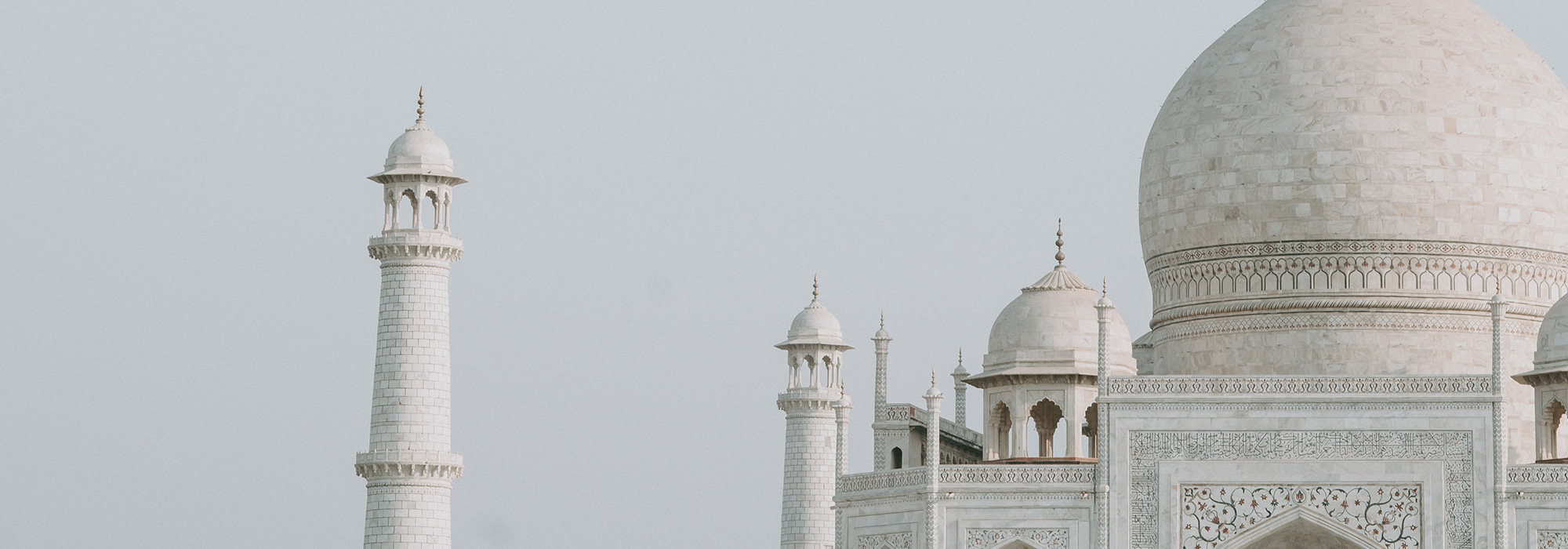- 1300 761 980

A spectacle in white marble, the Taj Mahal is one of the world’s most recognisable monuments. The Taj Mahal is also one of the New7Wonders of the world. This extravagant mausoleum depicts the divine opulence of the Mughal Empire. The story of the Taj is a story of a man’s eternal love for his wife.
Emperor Shah Jahan (initially named Prince Khurram) met his third wife, Mumtaz Mahal, at the age of 14. Five years after they met they were married in 1612. She was a Muslim Persian princess (her name Arjumand Banu Begum before marriage) and he was the son of the Mughal Emperor Jehangir and grandson of Akbar the Great. In 1628, Shah Jahan became the Emperor and entrusted Arjumand Banu with the royal seal. He also presented her with the title of Mumtaz Mahal, meaning the “Jewel of the Palace”. Although Shah Jahan did have other wives, Mumtaz Mahal was his favourite and accompanied him everywhere he went.
In 1631, when Mumtaz Mahal was giving birth to their 14th child, she died due to complications. While Mumtaz was on her deathbed, Shah Jahan promised that he would never remarry. He also promised to build the richest mausoleum over her grave. And so in honour of her memory, Shah Jahn commissioned the magnificent monument as a tribute to her, known today as the “Taj Mahal”.
When Mumtaz Mahal died, it is reported that the emperor refused to engage in court festivities along with postponing two of his sons’ weddings. Allegedly he made frequent visits to his wife’s temporary resting place (in Burhanpur) during the construction of the Taj. In popular literature, the legend of the Taj Mahal is referred to as an architectural “symbol of love”. While the Taj is a spectacle to witness, the history of the monument is what truly adds a soul to its magnificence. A soul built around a full circle feeling of love, loss, remorse, and love again. If it weren’t for Shah Jahan’s everlasting love for Mumtaz Mahal, the Taj would not exist.
The construction of Taj Mahal began in 1631. Artisans were summoned from the whole of the empire as well as Central Asia and Iran. Hundreds of stonecutters, inlayers, carvers, painters, calligraphers, and others made their way to the legendary site. Overall the Taj required the services of 22,000 workers and 1,000 elephants. The monument was built from white marble brought in from all over India and central Asia. It took 22 years for the complex to be built. In 1648 The Taj was completed with the surrounding monuments and gardens complete in 1653.
Shah Jahan died not as a ruler, but as a prisoner. Relegated to Agra Fort under house arrest for eight years prior to his death, Shah Jahan was only able to enjoy a distant view of the Taj Mahal. In 1666, Shah Jahn died and was laid to rest beside his favourite wife. The magnificent marble mausoleum he built stands tall, more than 350 years after it was constructed even and although the Indian rebellion in 1857 meant British soldiers and government officials tarnished the taj as well as chiselling out precious stones from its walls. Throughout its restoration in 1908, the Taj continues to be a symbol of love and a monument visited by millions around the world each year.
Suite 2, 1st Floor
261-271 Wattletree Rd
Malvern VIC 3144



For tailor-made itineraries or enquiries…